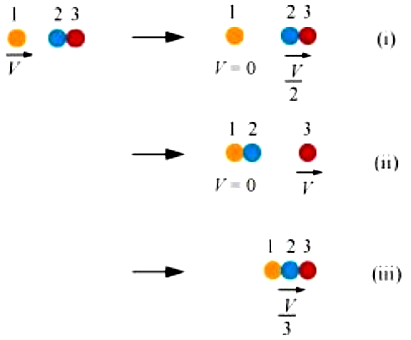A body is initially at rest. It undergoes a one-dimensional motion with constant acceleration. The power delivered to it at time \(t\) is proportional to,
1. \( t^{1 / 2} \)
2. \(t \)
3. \(t^{3 / 2} \)
4. \(t^2\)
1. \( t^{1 / 2} \)
2. \(t \)
3. \(t^{3 / 2} \)
4. \(t^2\)
A body is moving unidirectionally under the influence of a source of constant power. Its displacement in time \(t\) is proportional to,
1. \(t^{1/2}\)
2. \(t\)
3. \(t^{3/2}\)
4. \(t^{2}\)
A body constrained to move along the \({z}\)-axis of a coordinate system is subjected to constant force given by \(\vec{F}=-\hat{i}+2 \hat{j}+3 \hat{k}\) where \(\hat{i},\hat{j} \) and \(\hat{k}\) are unit vectors along the \({x}\)-axis, \({y}\)-axis and \({z}\)-axis of the system respectively. The work done by this force in moving the body a distance of \(4~\text m\) along the \({z}\)-axis will be:
1. \(15~\text J\)
2. \(14~\text J\)
3. \(13~\text J\)
4. \(12~\text J\)
A pump on the ground floor of a building can pump up water to fill a tank of volume in 15 min. If the tank is 40 m above the ground and the efficiency of the pump is 30%. Then electric power consumed by the pump is:
1. 44.4 kW
2. 44 kW
3. 40.7 kW
4. 45 kW
A body of mass 2 kg initially at rest moves under the action of an applied horizontal force of 7 N on a table with a coefficient of kinetic friction = 0.1. The work done by the applied force in 10 s is:
1. 882 J
2. 635 J
3. 247 J
4. 120 J

2. \({x}=\pm 2~\text m\)
3. \({x}=\pm 3~\text m\)
4. \({x}=\pm 4~\text m\)
Which one of the following statement is wrong?
| 1. | When a conservative force does positive work on a body, the potential energy of the body decreases. |
| 2. | Work done by a body against friction always results in a loss of its kinetic energy. |
| 3. | The rate of change of the total momentum of a many-particle system is proportional to the sum of the internal forces on the system. |
| 4. | In an inelastic collision of two bodies, the total linear momentum of the system of two bodies does not change after the collision. |
An electron and a proton are detected in a cosmic ray experiment, the first with kinetic energy \(10~\text{keV},\) and the second with \(100~\text{keV}.\) The ratio of their speeds is:
(take \(m_e=9.31\times 10^{-31}~\text{kg},\) \(m_p=1.67\times 10^{-27}~\text{kg},\) \(1~\text{eV}=1.60\times 10^{-19}~\text{kg}\) )
1. \(13.5: 1\)
2. \(1: 1\)
3. \(1: 13.5\)
4. \(2: 1\)
A raindrop of radius \(2~\text{mm}\) falls from a height of \(500~\text{m}\) above the ground. It falls with decreasing acceleration (due to viscous resistance of the air) until, at half its original height, it attains its maximum (terminal) speed, and moves with uniform speed thereafter. What is the work done by the gravitational force on the drop in the first and second half of its journey?
| 1. | \(0\) in each half | 2. | \(0.082~\text{J}\) in each half |
| 3. | \(17.87~\text{J}\) in each half | 4. | \(0.045~\text{J}\) in each half |
Two identical ball bearings in contact with each other and resting on a frictionless table are hit head-on by another ball bearing of the same mass moving initially with a speed V. If the collision is elastic, which of the following figure is a possible result after collision?

1. (i)
2. (ii)
3. (iii)
4. None of these.






